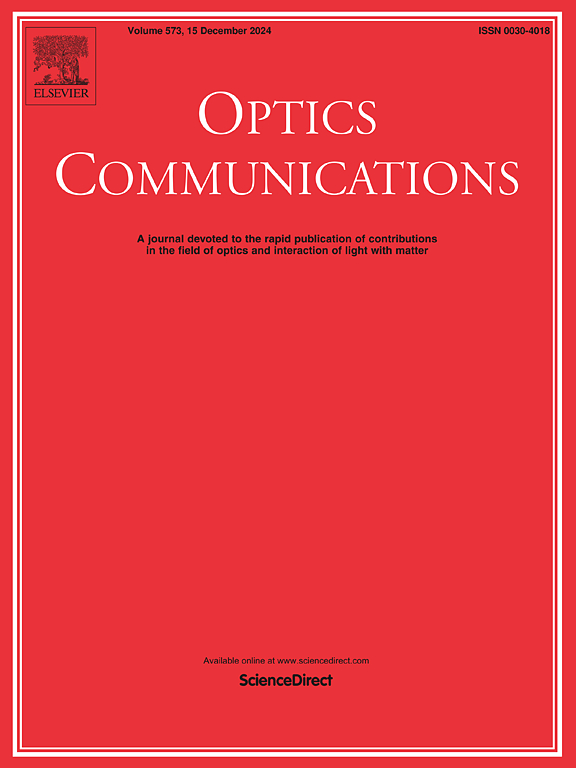Reproducible electronically controlled Fresnel lens based on the principle of dielectric phase separation
IF 2.5
3区 物理与天体物理
Q2 OPTICS
引用次数: 0
Abstract
A Fresnel lens with controllable diffraction efficiency based on the dielectric-induced phase separation was demonstrated. Two immiscible liquids with a large difference in dielectric constants, i.e., nematic liquid crystal (MLC-2140, Δε ∼ 47.6) and optical adhesive (NOA 65, εp ∼ 5) are mixed thoroughly and injected into a cell. The cell consists of a bottom substrate featuring a concentric ring-patterned electrode, a top substrate of ordinary glass, with a cell gap of 10 μm. When an external electric field exceeding the threshold is applied, phase separation occurs between the two liquids, the liquid crystal with high dielectric constant moves towards to the edges of the electrode rings and accumulates on the surface of the electrode, while the optical adhesive moves to the gap between the electrodes, finally forming a liquid crystal/optical adhesive Fresnel lenses (LCOFLs) with the aperture of 3.5 mm. Upon removal of the applied voltage, the LCOFLs return to a state where liquid crystal microdroplets are randomly dispersed within the optical adhesive, at which point there is no lensing effect. The LCOFLs can be simply switched between focused and defocused states at a reasonable speed, and the diffraction efficiency can reach 36.3 %, approaching the ideal value of 40.5 %. The proposed LCOFLs exhibits several advantages, including lightweight design, low power consumption, ease of fabrication, and low cost, making it highly promising for applications in various fields such as spectrometers, projection displays, long-distance optical communication, and variable optical data storage systems using a zone plate modulator.
基于介电相位分离原理的可重复电子控制菲涅耳透镜
设计了一种基于介电诱导相分离的菲涅耳透镜。将介电常数差异较大的两种不混相液体,即向列液晶(MLC-2140, Δε ~ 47.6)和光学胶粘剂(NOA 65, εp ~ 5)充分混合并注入电池。该电池由具有同心环形电极的底部衬底和普通玻璃的顶部衬底组成,电池间隙为10 μm。当外加超过阈值的电场时,两种液体之间发生相分离,高介电常数的液晶向电极环边缘移动并在电极表面积累,光学粘合剂向电极间隙移动,最终形成孔径为3.5 mm的液晶/光学粘合剂菲涅耳透镜(LCOFLs)。在去除施加电压后,lcofl返回到液晶微滴在光学粘合剂内随机分散的状态,此时没有透镜效应。lcofl能以合理的速度在聚焦和散焦状态之间切换,衍射效率达到36.3%,接近理想值40.5%。所提出的lcofl具有多种优点,包括轻量化设计、低功耗、易于制造和低成本,使其在光谱仪、投影显示器、长距离光通信和使用带片调制器的可变光数据存储系统等各个领域的应用前景非常广阔。
本文章由计算机程序翻译,如有差异,请以英文原文为准。
求助全文
约1分钟内获得全文
求助全文
来源期刊

Optics Communications
物理-光学
CiteScore
5.10
自引率
8.30%
发文量
681
审稿时长
38 days
期刊介绍:
Optics Communications invites original and timely contributions containing new results in various fields of optics and photonics. The journal considers theoretical and experimental research in areas ranging from the fundamental properties of light to technological applications. Topics covered include classical and quantum optics, optical physics and light-matter interactions, lasers, imaging, guided-wave optics and optical information processing. Manuscripts should offer clear evidence of novelty and significance. Papers concentrating on mathematical and computational issues, with limited connection to optics, are not suitable for publication in the Journal. Similarly, small technical advances, or papers concerned only with engineering applications or issues of materials science fall outside the journal scope.
 求助内容:
求助内容: 应助结果提醒方式:
应助结果提醒方式:


